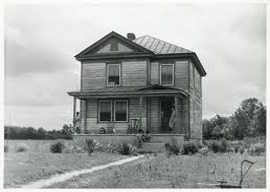
October 07, 2011

Reason’s Jim Epstein and Nick Gillespie say predatory eminent-domain policies often lead to a “bulldoze-and-abandon phenomenon.” After the LA riots, the government used eminent domain to seize a gigantic piece of land in South LA. They claimed the previous owners were neglecting the land, but the government’s had it for twenty years now and it’s still a vacant lot. These same idiots are displacing residents to build a football stadium they say will provide 6,500 jobs. Good luck with that. Yankee Stadium has about 27 full-time staffers.
Sometimes the government doesn’t even have to promise more jobs. New York City used eminent domain to evict stubborn old codger Stratford Wallace. Was he in the way of a hospital, a school, or even a library? Nope, he was living exactly where The New York Times wanted to put their headquarters. The Times is paying quite a bit more in tax than Wallace was.
The most famous case of eminent-domain abuse was 2005’s precedent-setting Kelo v. City of New London. The Connecticut town booted Susette Kelo out of her home because they thought it was a dump…and replaced it with an actual dump. America, left and right, was united in their rage at the Kelo verdict. When Justice Richard N. Palmer saw Kelo crying about the verdict, he consoled her with a very generous “I’m sorry.” Kelo now lives inside that gigantic apology and says it’s way better than her old place.
It’s not easy to fight the government, especially when it’s drinking big business Kool-Aid, but there have been victories. In Mesa, Arizona, Randy Bailey was told his brake repair shop sucked and would have to be given to the city via eminent domain. They were going to give it to a guy across the street who wanted to expand his hardware store. What? “If I had a ‘For Sale’ sign on my front lawn, it would have been a whole different deal,” Bailey said while fighting the case in court. Luckily, the judge realized taking one guy’s shop and giving it to another guy’s store is not why eminent domain was created.
A bigger victory came in a town near Cleveland called Lakewood after Mayor Madeline Cain told Jim and Joanne Saleet their home had to be replaced with a rich person’s house. Cain shamelessly claimed the city “cannot survive without a strengthened tax base,” but the Saleets wouldn’t go down without a fight. After the dust settled, the Saleets got to keep their home and Cain was out of a job.
In Battle for Brooklyn, Daniel Goldstein decided the government doesn’t deserve his home and along with thousands of people he fought the project. “We had traditional conservatives, Republicans, Democrats, liberals all on our side,” he told me recently. “It is refreshing when Americans of different pigeonholes can get out of those holes and work together.” Technically, Goldstein lost that particular battle because he was forced to leave his place, but he continues to wage war against eminent-domain abuse through his company Develop Don’t Destroy Brooklyn and in that sense, he’s already won. “I couldn’t be prouder about the seven-year fight I led and the community that opposed Atlantic Yards,” he adds. “And when my daughter is old enough to understand what occurred, I am certain she’ll be proud, too.”